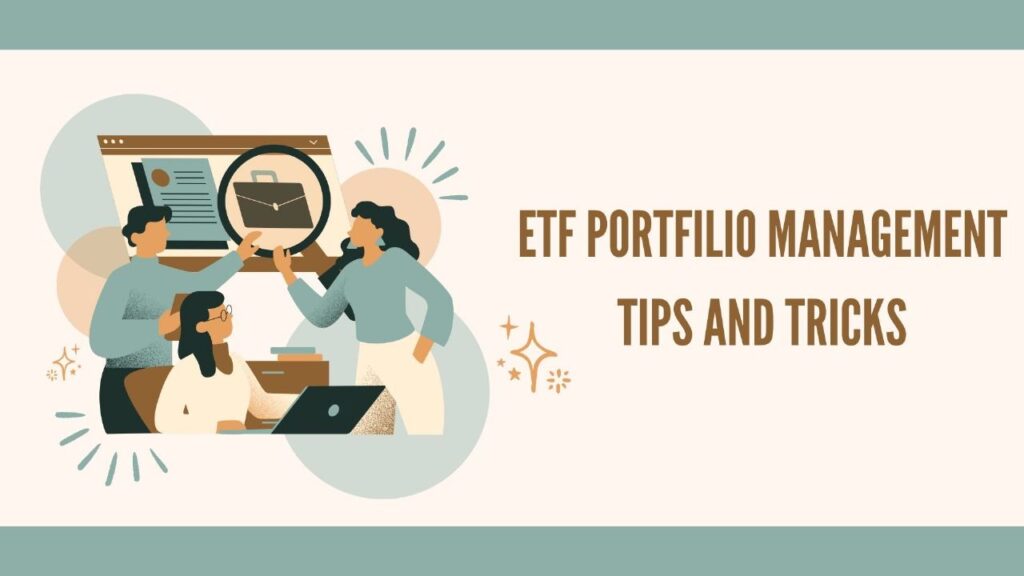
“ETF Portfolio Management: Tips and Tricks”
*ETF Trading Strategy: Ek शानदार invest option*
*Description:* ETF मेँ निवेश करना एक आकर्षक विकल्प है, लेकीन इसके लिये सही रणनीति कि आवश्यकताएं हैं. इस लेख में हम ETF trading strategy के बारे में जानेंगे और ETF में निवेश करने के tareeke को समझेंगे.
*Keyword:* ETF trading strategy, ETF investing, ETF mein nivesh kaise kare, ETF trading for beginners, ETF trading tips, ETF investment strategy
*ETF क्या है?*
ETF यह Exchange Traded Fund एक प्रकार का निवेश utpad है जो share बाजार में सुलभ है. Yah एक mutual fund कि तरह है, लेकिन इसे share की तरह खरीदा और बेचा जा सकता है.
*ETF Mein Nivesh Karne Ke Fayde*
1. विविधीकरण: ETF में निवेश करके आप अपने portfolio में विविधीकरण ला सकते हैं.
2. कम लागत: ETF में निवेश करने की लागत कम होती है.
3. Liquidity: ETF में निवेश करने से आपको liquidity मिलती हैं.
4. Niyantan: ETF में निवेश करने से आपको अपने निवेश पर niyantan मिलती है.
5. Flexibility: ETF में निवेश करने से आपको flexibility मिलती हैं.
6. Tax Labh: ETF में निवेश करने से आपको tax लाभ मिलती है.
*ETF Trading Strategy*
1. लंबी Avadhi कि रणनीति: ETF में निवेश करने के लिए लंबी अवधि की रणनीति अपनाएँ.
2. Vividhikaran: अपने portfolio में vividhikaran लाने के लिए vividh ETF में निवेश करें.
3. Niyamit Nivesh: Niyamit roop से ETF में निवेश करें.
4. Risk Management: अपने निवेश के जोखिम को कम करने के लिए risk management रणनीति अपनाएँ.
5. Technical Analysis: Technical analysis का उपयोग करके ETF में निवेश करें.
6. Fundamental Analysis: Fundamental analysis का उपयोग करके ETF में निवेश करें.
*ETF में निवेश करने के Tareeke*
1. Online Trading Platform: Online trading platform के माध्यम से ETF में निवेश करें.
2. Brokerage House: Brokerage house के माध्यम से ETF में निवेश करें.
3. Mutual Fund House: Mutual fund house के माध्यम से ETF में निवेश करें.
4. Direct Plan: Direct plan के माध्यम से ETF में निवेश करें.
5. SIP: SIP ke माध्यम से ETF में निवेश करें.
_ETF Returns with Calculation:
Calculating ETF returns is a crucial step that helps investors evaluate their investment performance.
_Types of ETF Returns_
1. Absolute Return: This calculates the ETF’s return as a percentage.
2. Relative Return: This compares the ETF’s return to a benchmark index.
_ETF Returns Calculation Formula_
Absolute Return = (Current Value – Initial Value) / Initial Value × 100
Example:
Initial Investment = ₹1,00,000 (approximately $1,375 USD)
Current Value = ₹1,20,000 (approximately $1,650 USD)
Absolute Return = (₹1,20,000 – ₹1,00,000) / ₹1,00,000 × 100 = 20%
_Factors Affecting ETF Returns_
1. Dividend Yield
2. Capital Gains
3. Interest Income
4. Expenses Ratio
_Evaluating ETF Returns_
1. Compare the ETF’s return to its benchmark index.
2. Compare the ETF’s return to its peer group.
3. Ensure the ETF’s return aligns with your investment objectives.
Returns of Some Popular ETFs:
1. Nifty 50 ETF: 15-20% per annum
2. Sensex ETF: 12-18% per annum
3. Gold ETF: 8-12% per annum
4. Debt ETF: 6-9% per annum
Note: These return figures are examples and actual returns may vary.
Note: Please keep in mind that the conversion rate used is approximate and may vary based on current exchange rates.
*ETF Trading Ke Liye Tips*
1. Shiksha Aur Anubhav: ETF trading के लिए शिक्षा और अनुभव आवश्यक है.
2. Risk Management: अपने निवेश के जोखिम को कम करने के लिए रिस्क management रणनीति अपनाएँ.
3. Niyamit Nivesh: नियमित रूप से ETF में निवेश करें.
4. Vividhikaran: अपने portfolio में vividhikaran लाने के लिए vividh ETF में निवेश करें.
5. Technical Analysis: Technical analysis का उपयोग करके ETF में निवेश करें.
ETF Investment Monopoly: क्या आपके पैसे Safe हैं?
ETF investment monopoly एक ऐसा मुद्दे hai जो niveshakon को सोचने पर मजबूर कर्ता है. Kya ETF में निवेश करना सचमुच safe हैं? क्या ETF companies आपके पैसे का misuse कर सकती हैं?
Here’s a comparison of ETFs with other investment options:
ETF Monopoly के नुकसान:
– आपके nivesh पर control कम होता है
– ETF companies आपके पैसे का misuse कर सकती हैं
– Nivesh के returns कम हो सकते हैं
– Risk बढ़ सकता है
ETF Monopoly Se बचने के Tareeke:
– Vividh ETF में invest करें
– नियमित रूप से portfolio review करेँ
– Risk management रणनीति अपनाएँ
– ETF companies कि रिसर्च करें
Aapke nivesh ki suraksha ke liye ETF monopoly se savdhan rahein.
*Conclusion*
ETF में निवेश करना एक आकर्षक विकल्प हैं, लेकीन इसके लिए सही रणनीति की avashyakta है. इस लेख में हमने ETF trading strategy के बारे में जाना और ETF में निवेश करने के tareeke को समझा.
Here are one-line FAQs for ETF investment:
*FAQs*
1. Q: What is an ETF?
A: An Exchange-Traded Fund (ETF) is a traded investment fund listed on a stock exchange.
1. Q: How do ETFs work?
A: ETFs track an index, sector, or asset, allowing investors to buy/sell like stocks.
1. Q: What are the benefits of ETFs?
A: Diversification, flexibility, transparency, and cost-effectiveness.
*Investment FAQs*
1. Q: How do I invest in ETFs?
A: Through online trading platforms, brokerage firms, or financial advisors.
1. Q: What is the minimum investment for ETFs?
A: Varies by ETF and brokerage firm.
1. Q: Can I trade ETFs intraday?
A: Yes, ETFs can be traded like stocks.
*Risk and Management FAQs*
1. Q: What risks are associated with ETFs?
A: Market, sector, and liquidity risks.
1. Q: How do I manage ETF risks?
A: Diversification, stop-loss orders, and regular portfolio rebalancing.
*Taxation and Fees FAQs*
1. Q: Are ETFs tax-efficient?
A: Generally, yes, due to pass-through taxation.
1. Q: What fees are associated with ETFs?
A: Management fees, trading commissions, and other expenses.
*Miscellaneous FAQs*
1. Q: Can I hold ETFs in my retirement account?
A: Yes, ETFs can be held in IRAs, 401(k)s, and other retirement accounts.
1. Q: How do I choose the right ETF?
A: Consider investment objectives, risk tolerance, and fees.